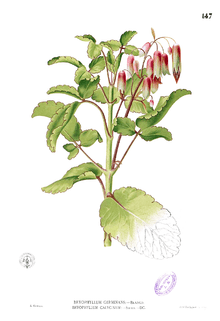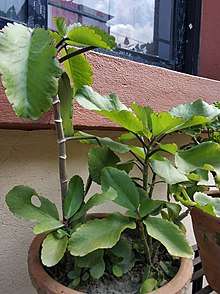Bryophyllum
Bryophyllum (from the Greek βρῦον/βρύειν bryon/bryein = sprout, φύλλον phyllon = leaf) is a group of plant species of the family Crassulaceae that is usually included as a section within the genus Kalanchoe (Kalanchoe section Bryophyllum), but has also been considered to be a separate genus. There are about forty species in the group, native to South Africa, Madagascar, and Asia. The group is notable for vegetatively growing small plantlets on phylloclade margins and tips. The plantlets drop off phyloclades and can root and grow into new plants in favorable places. The plantlets arise from mitosis of meristematic-type tissue in phyllocades.
| Bryophyllum | |
|---|---|
 | |
| The "Goethe Plant", Bryophyllum pinnatum, illustrated in Flora de Filipinas by Francisco Manuel Blanco | |
| Scientific classification | |
| Kingdom: | |
| (unranked): | |
| (unranked): | |
| (unranked): | Core eudicots |
| Order: | |
| Family: | |
| Genus: | Bryophyllum |
| Species | |
|
About 40, see text.[1] | |
Nowadays, bryophyllums are naturalized in many parts of the tropics, and deliberately cultivated for their attractiveness, interesting reproduction by plantlets on phylloclades, or both.
Taxonomy
Bryophyllum is not universally accepted as a separate genus, being included in Kalanchoe by some authorities, within subfamily Kalanchoöideae. Since species of Bryophyllum appear to be nested within Kalanchoe on molecular phylogenetic analysis, Bryophyllum is considered as a section of the former.[2][3][4]
Selected species
The three most commonly cultivated species are:
- Bryophyllum daigremontianum: Devil's Backbone or mother-of-thousands. Native of Madagascar; introduced and naturalized in many parts of tropical and subtropical Africa, Asia (Indian Ocean islands), North America (Florida) and South Africa; cultivated in Pakistan, India and Bangladesh for its medicinal properties. In Bangladesh it is known as Patharkuchi Pata.
- Bryophyllum pinnatum: Air Plant. Native of Tropical Africa, cultivated or naturalized on many Pacific Islands (Tonga, Hawaii). It is also called the "Goethe Plant" since the famous writer Johann Wolfgang von Goethe — who also was an amateur naturalist of some repute — was "passionately fond" of this plant and liked to give the baby plantlets as gifts to friends who visited his home. He also discussed his air plant at length in the essay that was titled Geschichte meiner botanischen Studien ("History of my botanical studies").
- Bryophyllum delagoense

.jpg)

Some other species in this section are:
- Bryophyllum beauverdii
- Bryophyllum bouvetii
- Bryophyllum campanulatum
- Bryophyllum fedtschenkoi
- Bryophyllum gastonis-bonnieri
- Bryophyllum laxiflorum
- Bryophyllum macrochlamys
- Bryophyllum manginii
- Bryophyllum marnierianum
- Bryophyllum miniatum
- Bryophyllum proliferum
- Bryophyllum pubescens
- Bryophyllum rolandi-bonapartei
- Bryophyllum rosei
- Bryophyllum schizophyllum
- Bryophyllum streptanthum
- Bryophyllum suarezense
- Bryophyllum uniflorum
Toxicity
Several species of Kalanchoe are economically important for causing cardiotoxic effects in sheep and cattle, and diseases affecting the nervous system and muscles known as krimpsiekte ("shrinking disease") or as cotyledonosis.[5] Bryophyllum pinnatum may have similar chemical components, bufadienolide alkaloids.[6]
There are many hybrids within Bryophyllum, and also hybrids with Kalanchoe such as Kalanchoe × crenatodaigremontiana (B. laxiflorum (as the synonym B. crenatum) × K. daigremontiana) or Houghton's Hybrid (K. daigremontianum × B. delagoense) .
References
- "The Plant List: A Working List of All Plant Species".
- POTWO 2019.
- Mort et al 2009.
- Eggli 2003.
- Welham, Marina: How Dangerous are Euphorbias? (And Others in the Family Euphorbiaceae) with some comments on dangerous plants in the families Agavaceae, Aizoaceae, Apocynaceae, Compositae, Crassulaceae, Liliaceae Archived 2007-10-01 at the Wayback Machine. The Amateur's Digest. Retrieved 2007-09-19.
- Steyn, Pieter S & van Heerden, Fanie R. (1998): "Bufadienolides of plant and animal origin". Natural Product Reports 15(4): 397–413. doi:10.1039/a815397y PDF fulltext
Bibliography
- Eggli, Urs, ed. (2003). Illustrated Handbook of Succulent Plants: Crassulaceae. Springer Science & Business Media. doi:10.1007/978-3-642-55874-0. ISBN 978-3-642-55874-0.CS1 maint: ref=harv (link)
- Mort, Mark E.; Soltis, Douglas E.; Soltis, Pamela S.; Francisco-Ortega, Javier; Santos-Guerra, Arnoldo (January 2001). "Phylogenetic relationships and evolution of Crassulaceae inferred from matK sequence data". American Journal of Botany. 88 (1): 76–91. doi:10.2307/2657129. JSTOR 2657129.
- Mort, Mark E; O'Leary, T. Ryan; Carrillo-Reyes, Pablo; et al. (December 2009). "Phylogeny and evolution of Crassulaceae: Past, present, and future". Biodiversity & Ecology. 3: 69–86.
- "Bryophyllum Salisb". Plants of the World Online. Royal Botanic Gardens, Kew. 2019. Retrieved 1 September 2019.
External links

